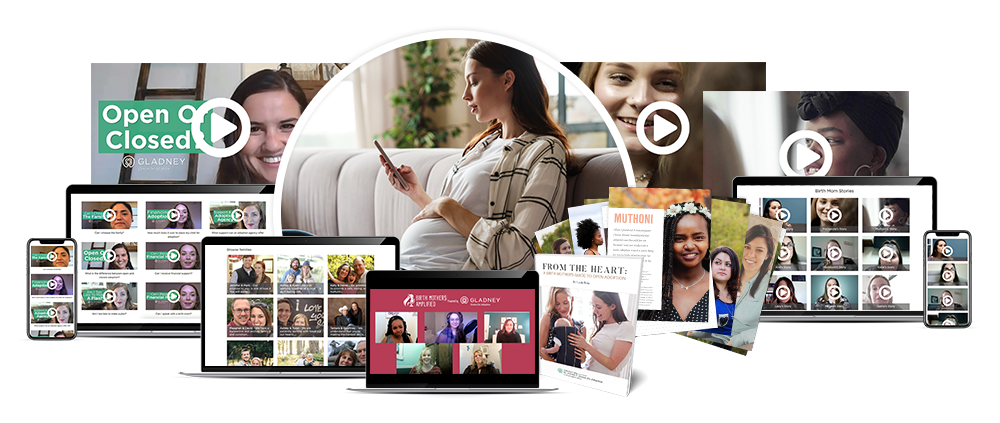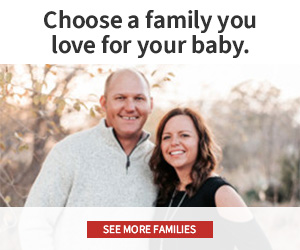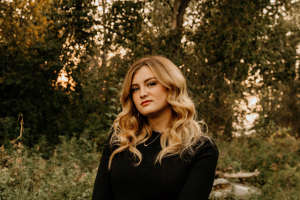When choosing an adoption plan, there are a variety of options available to ensure that you have an experience you feel comfortable with. Some of those options determine the relationship and presence of a birth parent in the life of her child and his adoptive parents.
There are three common adoption types: open adoption, closed adoption, and semi-open adoption. These options have different levels of communication as determined by birth parents and adoptive parents and sometimes the adoption agency involved.
Closed adoption refers to adoptions where there is no contact. These adoptions still occur but were even more common in generations past. Often, the names and identities are confidential, and there is no contact before or after the child is born.
“Open adoption” is a broad term, but it implies that the birth parents and adoptive family continue contact after the child is placed. This can entail phone calls, video chats, weekly emails, in-person visits, letters, etc. In an open adoption, there is room for change as the child ages or as either the birth parents or adoptive parents see fit. You may begin contact with little contact through letters or texts and gradually work your way up to occasional visits. It’s important in open adoptions to be very, well open about expectations and be consistent in communication.
Then, there are “semi-open adoptions.” Semi-open adoptions are often regulated by a third party and in most cases that the third party is the adoption agency. Semi-open adoptions have some conversation, but not often. In many cases, that communication looks like letters or emails sent annually.
Implementing Different Adoption Plans
My life is full of adoption stories. My sister and I were both adopted, my mom was adopted, my paternal grandmother was adopted, my uncle placed a baby for adoption, my husband has two adopted brothers, and the list continues on and on. I’ve been able to see closed adoptions, very open adoptions, and everything in between. My adoption journey is one of those “in-between” stories. I have loved my semi-open adoption.
I was placed for adoption when I was a mere five days old. When I begin to tell my adoption story, people often (if not always) ask when I found out I was adopted. My somewhat anticlimactic answer is that I always knew. It was important to my parents that I always knew about where I came from and about my birth parents.
My adoptive mom was adopted by her dad when she was a baby, but she didn’t know until she was 13 years old and accidentally stumbled upon a scrapbook she wasn’t allowed to look at. Flipping through the pages, she found a picture of a man holding her on the day she was born.
“Bill is such a good daddy,” an inscription read below the polaroid picture. My mom remembers thinking: “Bill? But my dad’s name is Rod…” After some probing and investigating with her older cousins, she was able to discover that her mom (my grandma) had been married before her dad but when they divorced and my grandma remarried her dad had decided to adopt her.
The inner-turmoil my mom went through at 13 years old was a formative experience. She remembers questioning who she was and feeling lied to. She would look at her siblings who all shared biological parents and feel like she was very different from them. It took years for her to settle into her new reality and for her to finally believe that her dad really did love her as much as her siblings, even if she wasn’t “biologically” his child.
When my parents adopted my older sister, Katelyn, my mom didn’t want her to experience the same thing she had if she found out she was adopted in her teenage years. At night, she would rock Katelyn to sleep and tell her things that her birth mother had written to my parents in a letter the day she was placed in their arms. She had written about how much she loved Katelyn and had hoped that she was doing well and getting loved by the family she had chosen.
My sister’s adoption was set up as a closed adoption with the understanding that when she turned 18 that she could request information about her birth parents from the state where she was born. Real names were not exchanged, my parents never met Katelyn’s birth mother, and there was no contact after the first year. During the first year, letters and pictures were exchanged but signed with fake names. Because my sister was born on Christmas day, the name her birth mother knew her as was “Noel.”
When she felt the time was right, Katelyn contacted the state of Idaho to inquire about her birth mother. At that point, there was a 30-day period in which either Katelyn could change her mind or her birth mother could decline the inquiry and retain the lack of contact. The waiting period passed and Katelyn was able to connect with her birth mother and her half-siblings.
Since then, our families have made a lot of memories together. We’ve been together for vacations and around the holidays. Katelyn, her half-sister, and I have all gotten married in the last couple of years and we have all been able to be at each other’s weddings which have been such a special addition to already joyous occasions.
My Semi-Open Adoption Journey
My adoption was set up differently than Katelyn’s. It was set up in what I referred to earlier as a semi-open adoption. In the few years between my sister’s birth and mine, semi-open adoptions became a lot more common (1995-1999). For me and my family, our semi-open adoption meant that we received photos and letters annually around my birthday until I decided to reunite in person when I turned 18.
We would send letters through the agency I had been placed through until I was almost 15 years old. To make a long, detailed story short, we decided to cut ties with the agency around that time and make our contact directly. There were still annual letters, but my birth mom and mom became Facebook friends. Then on my 16th birthday, I decided to send a friend request to my birth mother, Megan, as well.
I am grateful that once I entered my teenage years, I was trusted with the reins of comfortability. I sent the friend request when I felt ready, but there wasn’t pressure for me to send the request. I continued to send letters every year, but there wasn’t pressure for me to continue if I didn’t want to. I didn’t feel ready to text or call individually yet, so there wasn’t pressure on me to do that.
Part of the very-detailed severance from our agency came after the realization that my birth father was cut off from my family when I was only 5 years old. We don’t know to this day why he had been cut off when my birth mother wasn’t, but he was able to re-enter the picture shortly before I turned 15.
When that addition was made, I was grateful for how things were handled. It very much felt like communication was in my hands. Between me, my parents, and my birth father we decided to begin communication through annual letters, and I felt comfortable with each one of us following each other on Instagram.
Right before my senior year, I felt a strong desire to reunite with both of my birth parents in person. When I made that decision, I was supported. Plans were made and I was accompanied by my family on the trip to meet my birth mother initially, and then again two weeks later to meet my birth father.
The Needs of the Child Should Be Prioritized
Having a semi-open adoption was perfect for me. I tend to make decisions based on what I think other people would want me to do. For me as a young girl, I can imagine very easily how concerned I would be about what my birth parents would want me to do. As a teenager, I still wanted to make them proud, but I never felt like I had more people’s desires for me to consider than I could handle. My parents were able to raise me and support me in how they saw fit during those early years. So when my birth parents entered the picture, I had established my own character. (Which, lo and behold, was naturally very similar to my birth mom.)
There are countless factors to consider with adoption. But first and foremost are the needs and comfort of the child. Something I have grown to understand as I’ve gotten older is that arguably the biggest decision of my life was made for me, and I had no say in it. I don’t harbor negative feelings about that, but I do have an immense amount of gratitude for the fact that I have been able to call shots as I’ve gotten older.
Pregnant and considering adoption?
Get your free adoption benefits and support bundle

The first year or so after in-person reunification was a little rocky, as there was a learning curve of communications and boundaries. There were expectations and anticipations that not everyone involved had accounted for. As we worked through that the ultimate goal was to have a healthy relationship with the involved parties.
I adore my family, adoptive, and biological. I’m grateful to have established healthy boundaries with everyone. I’ve been blessed to have a situation where everyone wants what’s best for me. Any misunderstandings are quickly resolved because regardless of misinterpretations, there is always the basis of love.
And that’s how adoption should be.
Is Semi-Open Adoption the Right Choice for You?
If you are in a position where you are considering if adoption is for you, either to adopt or to place, consider your options. In my opinion, there are a lot of benefits to semi-open adoptions. You can set a baseline of communication but then there is also ample room to adjust as needed for the child in the picture. Maybe my stance is biased because I’m the “child” in my adoption story, but I think the child should always be the focus. A huge, life-altering decision was made for her, so now it’s the adults’ job to make that decision as good and as comfortable as possible for her upbringing.
I do want to be clear to both the adoptive and biological parties though. You can’t make promises you don’t intend to keep. If as a hopeful adoptive parent you promise visitation or communication as a contingent obligation, then don’t revoke your promise once the rights are signed to you. Don’t promise something just to adopt a baby that you do not plan on keeping. Semi-open adoptions allow a little room for adjustments, but that doesn’t mean you have room to infringe on trust. If something occurs or you notice behavior that would be unhealthy around your child, that’s when you would limit or remove the contact.
With the well-being of the child as your top priority, you will know what to do to ensure that his or her upbringing will be as comfortable as possible. An adopted child has the potential to be as comfortable with the fact that he was adopted as he is with the fact that he likes to sing, play baseball, or bake.
I remember a time during my freshman year of high school where a peer commented how “you must hate your birth mom for abandoning you.” Because of the relationship I had with my birth mom in our semi-open adoption, I felt the love from and for her beyond words. I was sad that my peer was under the impression that I was placed because I wasn’t loved, but at that moment, I was exceedingly grateful that I had a special bond with my birth mom. The way our communication was set up was such that my letters came from her around my birthday each year. Receiving letters and sometimes little accessories from her was usually my favorite part of my birthday celebration, and I wouldn’t trade that for anything.
My semi-open adoption was exactly the journey my life needed to take. If you are deciding to place or deciding to adopt and aren’t sure if you would be more comfortable choosing the route of an open adoption or closed adoption, I would implore you to remember that there is a place in the middle — semi-open adoption.
Considering adoption? Let us help you on your journey to creating your forever family. Visit Adoption.org or call 1-800-ADOPT-98. Are you considering placing a child for adoption? Do you want more choices with your adoption plan? Do you want to regain more control in your life? Visit Adoption.org or call 1-800-ADOPT-98. We can help you put together an adoption plan that best meets your needs.


